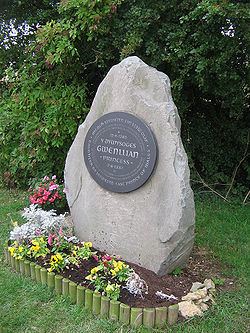Name Gwenllian Wales | ||
 | ||
Died June 7, 1337, Gilbertine Order Parents Eleanor de Montfort, Llywelyn ap Gruffudd Grandparents Simon de Montfort, 6th Earl of Leicester, Eleanor of Leicester, Senana ferch Caradog Similar People Llywelyn ap Gruffudd, Eleanor de Montfort, Simon de Montfort - 6th Earl o, Eleanor of Leicester | ||
Gwenllian of Wales or Gwenllian ferch Llywelyn (June 1282 – 7 June 1337) was the only child of Llywelyn ap Gruffudd, the last native Prince of Wales (Welsh: Tywysog Cymru). She is sometimes confused with Gwenllian ferch Gruffudd, who lived two centuries earlier.
Contents
- Lineage
- At the mercy of King Edward I
- Confinement for fifty years
- Old age and death
- Fate of her male cousins
- Gwenllian in later culture
- References
Lineage
Gwenllian (pronounced [ɡwenˈɬi.an]) was born in the Gwynedd royal home in Abergwyngregyn near Bangor, Gwynedd. Gwenllian's mother, Eleanor de Montfort, died during childbirth, or shortly afterwards, on 19 June 1282. Gwenllian was descended from dual royal bloodlines: not only was she the daughter of the Prince of Gwynedd and heiress of the royal family of Aberffraw, but her maternal great-grandfather was King John of England.
At the mercy of King Edward I
A few months after Gwenllian's birth, north Wales was encircled by the English army of King Edward I. On 11 December 1282 her father, Llywelyn ap Gruffudd, was killed in battle; the exact circumstances are unclear and there are conflicting accounts of his death. Both accounts agree, however, that Llywelyn was tricked into leaving the bulk of his army and was then attacked and killed. Gwenllian's uncle, Dafydd ap Gruffudd, assumed her guardianship, but on 21 June 1283, he was captured with his family at Nanhysglain, a secret hiding place in a bog by Bera Mawr in the uplands of north Wales. Dafydd, severely injured, was taken to Rhuddlan then moved under guard to Shrewsbury, where he was later executed.
Confinement for fifty years
Gwenllian and the daughters of her uncle Dafydd ap Gruffudd were all confined for life in remote priories in Lincolnshire and never allowed freedom. It has been speculated that the girls were taken to Lincolnshire from Gwynedd by sea.
Gwenllian was placed in the Gilbertine Priory at Sempringham, where she was held behind high walls until her death 54 years later. In committing her to a convent, Edward's aims were not only to prevent her from marrying and having sons who might lay claim to the Principality of Wales, but also to hide her away, unknown to the outside world. He chose Sempringham Priory in Lincolnshire because of its remote location and because the Gilbertines were an order in which nuns were hidden from view behind high walls.
Gwenllian's royal rank was acknowledged at least once by the English Crown. When writing to the Pope, attempting to secure more money for Sempringham Priory from the Church, the English king stated that "...herein is kept the Princess of Wales, whom we have to maintain."
Having been taken from her native land so young, Gwenllian never learned any Welsh, and perhaps never even knew the correct pronunciation of her own name. Documents indicate that the priory record-keepers were not sure how to spell her name; she is listed as "Wencilian" and was herself shown to have signed her name "Wentliane".
Old age and death
Edward III of England, Edward I's grandson, endowed Gwenllian with a pension of £20 per year; this was not money for her personally, simply a sum paid on her behalf to the priory in respect of her food and clothing. Her death there was recorded by the priory's chronicler in June 1337, a few days before her 55th birthday.
Fate of her male cousins
Dafydd's two young sons, heirs to the Principality or Kingdom of Wales, were taken to Bristol Castle, where they were held prisoner; Llywelyn ap Dafydd died there in 1287, four years after his capture, and was buried in the Dominican Church. Owain ap Dafydd survived (his brother); the King of England ordered a cage made of timber, bound with iron, in which to hold Owain ap Dafydd more securely at night. Owain was never released from imprisonment.
Edward I took the title of "Prince of Wales" for the Crown, bestowing it upon his son, Edward, at a Parliament held in Lincoln in 1301 at the age of seventeen. The title is still given to the heir apparent to the British crown to this day.
